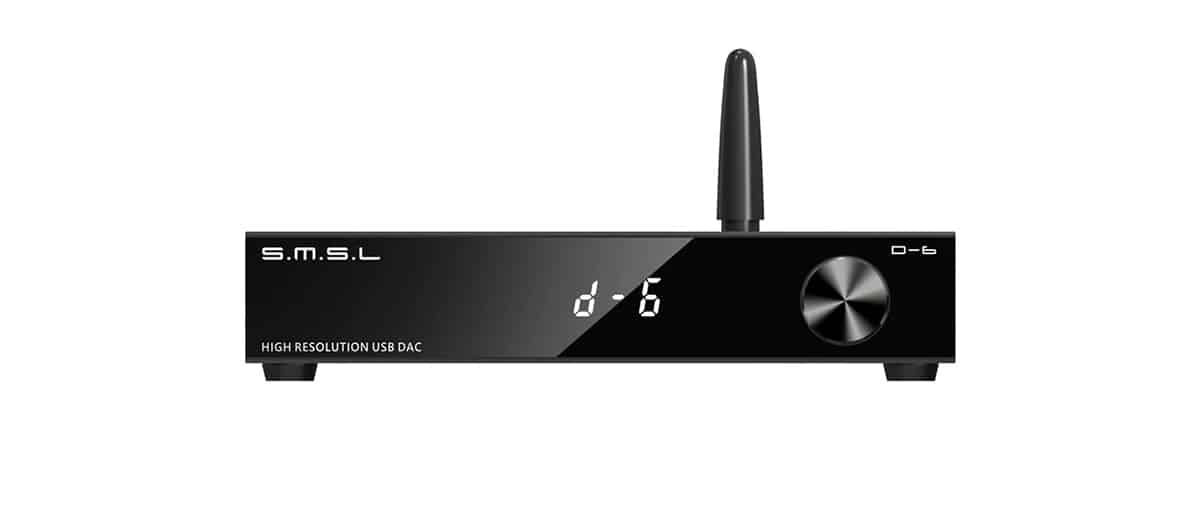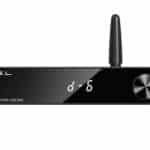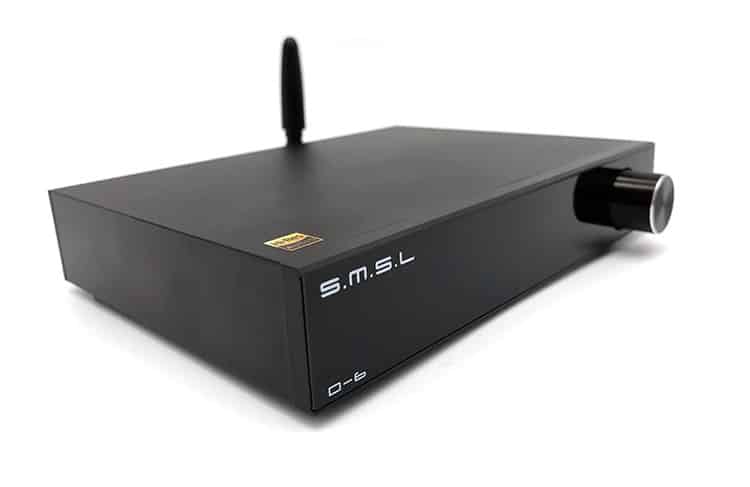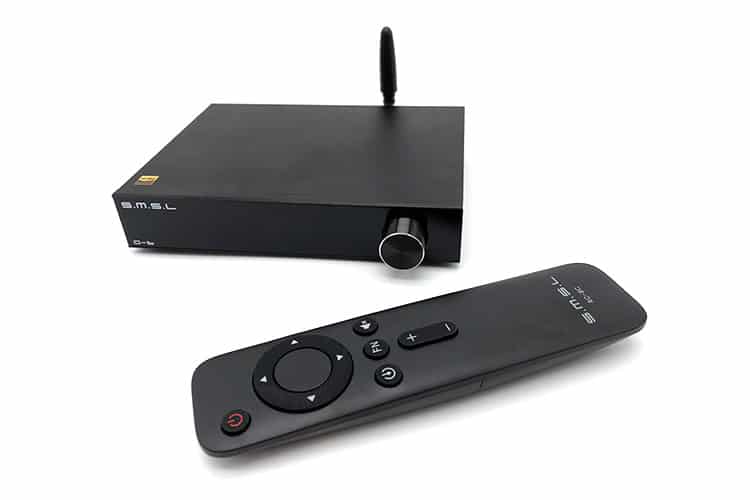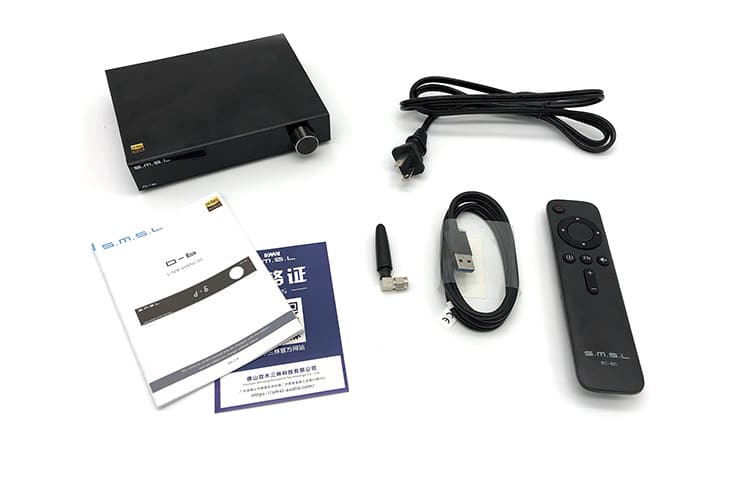This is an in-depth review with comparisons of the new SMSL D-6 DAC which is a dual-chipset desktop design offering up to 32BIT/768kHz decoding. It is priced at $169.99
Disclaimer: This sample was sent to us for our honest opinion. Headfonics is an independent website with no affiliate links or partnerships. We thank Shenzhen Audio and SMSL for giving us this opportunity.
Click here to learn more about SMSL products that we have previously featured on Headfonics.
Note, that this article follows our latest scoring guidelines which you can find in more detail here.
Upon hearing that the latest entry-level DAC from SMSL will be sporting chipsets from AKM, I was immediately excited that the long-time DAC chip manufacturer is back in the game after their hiatus.
SMSL even did a side-by-side comparison on their website between their recently released SU-6 using the ES9038Q2M decoder and the D-6 to stress the difference in DAC chip manufacturers.
Having said so, being well within the budget category, what the D-6 allows is for budding enthusiasts to take a different route coming from the increasingly saturated ESS Sabre DAC market. Even against the slightly more expensive SU-6, it holds its own by not just being similarly compact but also by squeezing in a balanced output option.
Now, those that follow the Chinese audiophile equipment scene would have noticed the plethora of great options hitting the market, saturating every niche there is. The D-6 is adding to the list by being the latest budget AKM DAC option from SMSL packaged in a negligible footprint for minimal setup lovers.
Tech Highlights
The SMSL D-6 uses dual AKM AK4493 chips with a balanced output capability from the TRS sockets at the back of the unit. But simply having the ability to downstream this way does not equate to ease of pairing as not a lot of other equipment, at least in the enthusiast space, is using TRS inputs.
The D-6 is compatible with 32bit/768kHz PCM playback and DSD512 via a second-generation XMOS module using a wired connection through USB-C. With the optical and coaxial inputs though, only PCM files with lower sampling rates will play through but there is no workaround for DSD.
While the D-6 has no MQA, which for some is not needed anyways and simply increases cost, it thankfully kept around Bluetooth for wireless listening. If anything, SMSL did not skimp on this feature using the QCC5125 chip to enable SBC, AAC, APTX HD, and LDAC connections.
Design
Taking the SMSL D-6 out of its box, I found the matte black anodized aluminum alloy chassis predictable having gotten acquainted with the long list of SMSL devices doing the same. Instead, my focus immediately went to the reassuringly hefty yet very compact and unassuming case of the D-6.
Looking towards the side of the D-6 shows an easily missed sloping edge superficially biting the front panel breaking the squared-off frame of the DAC. This type of design upholds the same low-key attitude SMSL uses with its every release.
Coming from a budget-conscious tier, the panel used upfront to protect the seven-segment display and infrared receiver is plexiglass instead of tempered glass used by some of SMSL’s more expensive offerings.
Here, the volume wheel protrudes 1 cm proud of the face of the device which is more than sufficient to turn the dial when accessing the settings and adjusting the volume.
Neatly separating the left half for the inputs and the right half for outputs, the almost perfectly linear arrangement on the rear of the D-6 showcases the fine work SMSL put into creating a feature-rich yet compact device.
Aside from being clean and functional, the rear section of the D-6 also holds the chassis together hiding six screws.
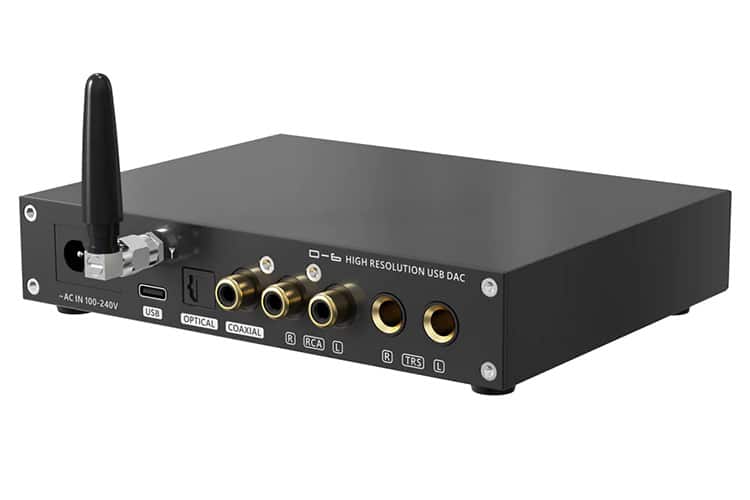
I/O
With built-in low noise power, the SMSL D-6 accepts 100-240V right out of the box using a two-prong power cable. This is not the first SMSL DAC using an ungrounded wall connection but the decision is probably to save some space internally to keep the compact chassis.
And impressive for its diminutive size, SMSL still managed to include four ways to interface with the D-6 for inputs. Customers will be pleased to have the freedom to choose between Bluetooth, USB-C, Optical, and Coaxial.
For its output section, SMSL went more creative and fitted a less common TRS connection for users with balanced gears extending the D-6 capability to more use cases. Joining the balanced socket for those with simpler setups, a pair of single-ended RCA outputs is still available.
Controls
Turning on the SMSL D-6 is as simple as plugging the two-prong power cable into the wall since it doesn’t have a dedicated switch. From the factory, the display will straightaway light up showing the startup sequence but the unit can remember to stay on standby for next time.
Before digging through the menu, I first went ahead and turned the volume wheel which read quickly and positively each time. It is a bit different from other DACs I’ve tried as the set maximum volume is at 60 which is lesser in range than usual.
Either by remote or the multifunctional volume knob, accessing the menu is easily within reach and user-friendly for changing the inputs, filters, brightness, and more. Between the two methods, using the included remote feels faster and more natural, plus it has the added assistance of putting the DAC on mute and changing inputs with a single press.
Packaging & Accessories
The box of the D-6 is on the smaller side for an SMSL package giving hints of its content’s dimensions but is just as unpretentiously designed. Only the hinged top lid of the white carton needs to be opened to carry on with unboxing.
Inside, the generously foamed interior is divided into two sections. The left side is keeping the paper works and the DAC draped in thin plastic safe, and on its right are the accessories.
There’s nothing worth pointing out about the included remote, Bluetooth antenna, and ungrounded two-prong cable. The provided USB type C to type A cable though is generously thick and not at all cheap feeling.
Sound Impressions
Summary
Jumping onto the AKM chip bandwagon, I did splurge on a used Cayin iDAC-6 a few years back to experience the sound of an AK4490 digital to analog converter. I still fondly recall the expansive and serenading flavor it gave to every kind of music it played.
The AK4493 on the SMSL D-6 carries the same wide-ranging presentation but SMSL’s implementation moved away from the smoothness I expected to be more energetic and hard-hitting. DAC chip legacy aside, those interested in a clean and engaging solid-state DAC will enjoy the technicalities of the D-6.
The main body of the bass is fast and capable, just don’t expect a rousing rumble to come from the timid but well-extended sub-bass. Moving up the scale, the detail retrieval on the midrange and treble is more than qualified for the price but intent listeners will quickly notice some shrillness and loss of refinement in a busier mix.
Timbre
In creating an identity toward critical listening, there’s no removing the fact that the D-6 hopes to be a tool for honest music playback. And throughout my listening impressions, it is the lower frequencies that achieve this target the easiest.
Understated yet audibly present, the seriousness in the beating of drums is strewn with pliability rounding up the speedy punch. It also adds intention to the body of bass guitars but those familiar with their music might miss out on subtleties and bite.
The D-6 begins introducing its individuality with piano notes receiving a lift in tension and thinness in pitch. Reverberating firmer than expected, the space created is quite confined having less priority in dispersion.
Having an expansive clarity, the nuance and air from relaxed singers shine with the D-6. However, since there is not a lot of weight and soul that is infused in the mix, the D-6 maintains a plainer affection on acoustic songs wherein it also slackens guitar strings.
Putting on some brighter melodies, the D-6 pushed forward the parts where a female singer is reaching for a higher note. This spike in upper midrange energy continues to the treble region giving the upper ranges of songs a sprightlier sound.
The zing and extension of the treble region will immediately immerse those wanting this kind of energetic vibe. Cymbals do have a steely and elevated splash besides a trombone arriving with great crescendos, but both instruments can also be described as lean and clinical, especially when listening loudly.
If paired with sharp gears, what I will avoid listening to with the D-6 is piercing electric guitar solos. I know what a well-rendered riff sounds like but the D-6 loses finesse and at times makes it fatiguing to listen.
Staging & Dynamics
Not bad but could be better, the sonorous energy of a clapping audience formed an outburst of expansive but slightly tense scene coming from the stiffer timbre. The images are pushed quite far apart and the well-extended treble helps in creating a vibrant and airy soundscape.
Image size is on the smaller side especially checking on the beating of kick drums and acoustic instruments. One thing it does provide well though is the easy-to-locate placement and directionality of the music played.
Having a lively upper midrange though may put some singers unnaturally more forward than expected as compared to the more even distribution of the bass which typically positions itself further away.
Lastly, the SMSL D-6 does have a pretty decent dynamic quality. My only reservation is on busier tracks that push an immense amount of top-end oomph which blurs the definition.
Bluetooth
Like most other Bluetooth receivers these days, the D-6 maintains a strong connection with my streaming device even outside two walls and 10 meters away. The Bluetooth connection will disengage if a different input is used but pairing back is almost instantaneous the moment it gets selected.
While testing for the range of the signal and some other functions, I did however notice a slight change in the technicalities of the D-6. Simply put, it traded some definition for a more relaxed tonality.
The top-end most obviously reduced in vigor with cymbals dispersing more and hitting not as hard. The exciting energy of electric guitars was taken down a notch making it less edgy.
Vocals are still shouty on the upper spectrum but less fatiguing and almost as nuanced. Instruments such as piano and guitars though similarly tuned even in Bluetooth did receive a bit of blunted response in reverb.
Where the wireless function moves further away from the intention of the D-6 is in the bass region becoming warmer and more bloated sounding.

